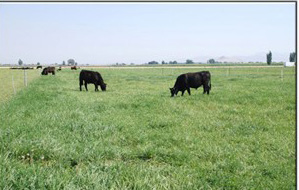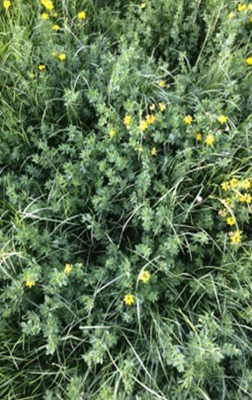BACKGROUND AND OBJECTIVES
 Beef cattle production is one of the dominant agriculture sectors in the United States, and most of the 30 million beef cows spend at least part of each year grazing pastureland. For decades, ranchers have enhanced the forage value of pastures by applying nitrogen-rich fertilizers to increase pasture productivity and cattle weight gain. However, the environmental consequences of applying high levels of nitrogen, which can runoff pastures into waterways, is now a major environmental concern.
Beef cattle production is one of the dominant agriculture sectors in the United States, and most of the 30 million beef cows spend at least part of each year grazing pastureland. For decades, ranchers have enhanced the forage value of pastures by applying nitrogen-rich fertilizers to increase pasture productivity and cattle weight gain. However, the environmental consequences of applying high levels of nitrogen, which can runoff pastures into waterways, is now a major environmental concern.
Reduced public grazing, increasing feed costs, and new grazing-associated environmental regulation all threaten the future sustainability of the beef cattle industry in its current configuration. Improving grazing systems so that the level of productivity is at least maintained, while maintaining environmentally sustainable systems, is critical for the survival of the beef cattle industry.
The rising costs of nitrogen fertilizer coupled with the potentially negative environmental effects of applying fertilizer to pastures is especially problematic given that nitrogen is often the limiting factor to increased forage, especially in the highly productive, irrigated pastures of the western U.S. To support beef producers in facing this challenge, the objective of this project is to develop alternatives to applying nitrogen-rich fertilizers while also placing an increased emphasis on environmental stewardship. One possible answer to both concerns is to integrate alfalfa and other legumes into highly productive, irrigated pastures. These legumes fix nitrogen into the soil, working as replacement for applying chemical nitrogen.
The overall objective of this project was to evaluate the economic and environmental benefits of grass-legume pasture mixtures as compared to using commercial nitrogen fertilizer.
ACTIONS
Scientists from the U.S. Department of Agriculture’s (USDA) Agricultural Research Service (ARS) in Logan, UT, and Utah State University, compared pasture productivity,
beef steer growth, economic return, and environmental impact (e.g., nitrogen leaching potential and greenhouse gas production) of tall fescue pastures mixed with alfalfa
or birdsfoot trefoil compared to fescue-only pastures with nitrogen fertilizer. Tall fescue is a popular pasture grass widely grown in the United States. It produces substantial forage and is typically very responsive to supplemental irrigation and fertilizer. Alfalfa and birdsfoot trefoil are both nutritious perennial forage legumes that, with the aid of rhizobium (root-colonizing bacteria), produce and deposit nitrogen in the soil. When grown in mixtures with grass, these legumes can potentially supply some of the large nitrogen requirement needed for productive pastures. Birdsfoot trefoil plants also contain low levels of condensed tannins. Tannins have been shown to improve protein digestion and utilization by livestock, including cattle, so that there is less nitrogen and ammonia excreted and lower levels of methane (greenhouse gas) emissions.
To compare the two systems, Angus beef steers were allowed to graze through two summers (May to September) on either tall fescue pastures mixed with alfalfa or birdsfoot trefoil or fescue-only pastures that had received nitrogen fertilizer. Scientists measured forage mass, nutritive value, steer growth performance, and production economics. In addition, cooperating producers planted these same mixtures on their farms and observed cattle grazing behavior and growth.
 RESULTS
RESULTS
The grass-legume mixed pastures produced slightly less forage, but nutrition and steer growth were higher compared to fertilized grass pastures. Researchers determined that the amount of dietary energy, fiber, and digestibility, and proportion percentage of legume in the forage, were the primary influencers of the differences in steer growth.
Social: Grazing on pastures has been shown to benefit society at large as it reduces concentrated manure storage (odor, flies, and nutrients), reduces use of fossil fuels to harvest forages, can improve livestock health, and has high public acceptance. Nearly 50% of western U.S. beef cattle are from small- to medium-sized farms, often relying heavily on grazing, and owned and operated by families that form the backbone of rural communities. This research documented cost-saving, quality of life, and good environmental practices that will help farms remain multi-generational and public-friendly, thus supporting stable rural communities.
Environmental: The grass-trefoil mixtures enhanced digestion for grazing cattle, resulting in less production of greenhouse gases, ammonia, and methane. In addition, both grass-legume mixtures produced less excess nitrogen in the water that leached through the soils compared to nitrogen fertilizer; this reduced nitrogen leached could help mitigate groundwater contamination.
Economic: Without the added cost of fertilizer, economic returns for grass-legume pastures were 2.4 (trefoil) and 1.7 (alfalfa) times greater than fertilized grass pastures. Importantly, economic returns for both grass-legume pastures were equal to or better than growing irrigated wheat or corn (common crops in the area), demonstrating an alternative to public land grazing when high-quality irrigated pastures are available. Also, grass-legume mixtures can reduce dependence on petroleum-based commercial fertilizer.
SUCCESSES AND LESSONS LEARNED
By nature, grazing research on a landscape scale is highly variable, resource intensive, and requires expertise in livestock, forages, and environment.
Success of the initiative was in part due to a multi- disciplinary team, external grant funding, excellent grazing research facilities (Utah State University), and farmer input on research questions and ‘proof of concept’ on-farm evaluations. The results not only showed the economic and environmental benefit of grazing grass-legume mixtures but indicated that such mixtures with a greater proportion of legume (up to 50%) or added dietary energy may provide even further benefits. This led to two subsequent grass-legume grazing research projects. An important lesson was the discovery that that there were major differences between the cows themselves. Some cows were more efficient grazers than others. In this study, data was based on the average of a group of three steers grazing together but collecting data on each steer would have shown that some steers are better for grazing grass-legume mixtures.

